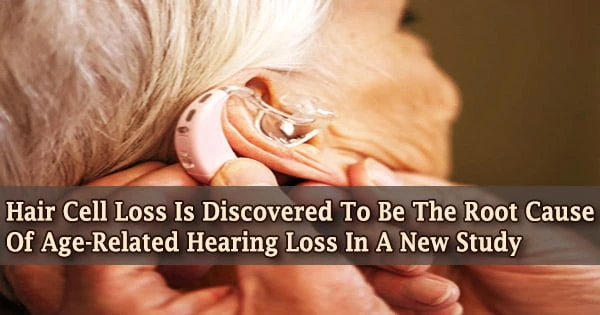Hearing scientists have discovered that damage to hair cells, the sensory cells in the inner ear that convert sound-induced vibrations into electrical signals that are relayed to the brain by the auditory nerve, is the main cause of age-related hearing loss, also known as presbycusis, in a new study of human ear tissues.
Their findings contradict the long-held belief that hearing loss is caused mostly by injury to the stria vascularis, the cellular “battery” that drives the hair cell’s mechanical-to-electrical signal conversion. The inner ear, which is the source of most types of hearing loss, cannot be biopsied, and its delicate structures can only be studied in postmortem specimens.
Nearly 2.5 billion people are expected to have hearing loss by 2050, with at least 700 million requiring hearing rehabilitation. Due to dangerous listening habits, almost 1 billion young individuals are at risk of irreversible, avoidable hearing loss.
To scale up ear and hearing care services internationally, an annual incremental investment of less than US$ 1.40 per person is required. Nearly 80% of persons who suffer from hearing loss live in low- and middle-income nations. Hearing loss becomes more common as people get older; about 25% of people over the age of 60 have disabling hearing loss.
According to the study authors, who were led by Pei-zhe Wu, MD, a postdoctoral research fellow in Otolaryngology-Head and Neck Surgery at Massachusetts Eye and Ear, “understanding the true cellular causes of age-related hearing loss impacts how future treatments are developed and how appropriate candidates are identified, and can also suggest how to prevent or minimize this most common type of hearing damage.”
Understanding the true cellular causes of age-related hearing loss impacts how future treatments are developed and how appropriate candidates are identified, and can also suggest how to prevent or minimize this most common type of hearing damage.
Pei-zhe Wu
“Our study upends the dogma about the major cause of age-related hearing loss,” said Dr. Wu. “Documenting the dominant role of progressive hair cell loss in the hearing impairment of normal aging means that the millions who suffer with this condition could benefit from the hair cell regenerative therapies that are the focus of ongoing research across the world. No one is focusing on approaches to regenerate the stria.”
The new study was published online July 20, in Journal of Neuroscience (JNeurosci).
New algorithms and new techniques developed to uncover the true cause of age-related hearing loss
Researchers looked at 120 inner ears taken from autopsies. They compared data on the survival of hair cells, nerve fibers, and the stria vascularis with the patients’ audiograms to find the key predictor of hearing loss in this elderly population using multivariable statistical regression. They discovered that the intensity and pattern of hearing loss were predicted by the degree and location of hair cell death, but not by stria vascularis damage.
Previous research looked at fewer ears, rarely attempted to synthesize data from different instances, and used less quantitative methods. Most importantly, previous studies grossly underestimated the loss of hair cells because they didn’t employ the cutting-edge microscopy techniques that allowed Wu and colleagues to see the tiny bundles of sensory hairs (> 200 times thinner than a typical human hair), allowing them to identify and count the few surviving hair cells. Hair cells were previously classified as “present” even if just one or two remained in previous investigations.
Cellular cause behind age-related hearing loss questioned
Hearing loss is one of the most prevalent conditions affecting older individuals in the United States; over one-third of those aged 65 to 74, and nearly half of those aged 75 and older, have hearing loss. The condition is irreversible and frequently necessitates the use of hearing aids or other sound amplification devices.
Previous animal research revealed that atrophy of the stria vascularis, a highly vascularized cluster of ion-pumping cells in the inner ear close to the hair cells, is the cause of presbycusis.
The stria acts as a “battery,” supplying energy to the hair cells as they convert mechanical motions produced by sound into electrical signals. When aging laboratory animals, such as gerbils, are compared to humans, there is very little loss of hair cells, even at the end of life.
The stria vascularis, on the other hand, is severely damaged, and damage to the stria will result in hearing loss. Most scientists assumed that the aging gerbil findings applied to human presbycusis before this recent study.
The new findings, according to the researchers, are encouraging considering recent advances in the development of medicines to restore lost hair cells. Hair cell regeneration therapy would be ineffective if presbycusis was caused predominantly by strial damage.
This new study suggests that as these novel therapies become available in clinics, maybe over the next decade, a large proportion of hearing-impaired elderly individuals will benefit.
Findings point to importance of protecting ears from sound damage
Hair cell degradation in aging humans is significantly worse than in animal models of presbycusis, according to the findings. Laboratory animals grow up in sound-proofed enclosures, away from the constant assault of moderate and high-intensity noises that surround us: those we choose to listen to and those we can’t.
“The greater hair cell death in human ears suggests that the high-frequency hearing losses that define presbycusis may be avoidable, reflecting mainly accumulated damage from environmental noise exposures,” said M. Charles Liberman, Ph.D., Director, of the Eaton-Peabody Laboratories at Mass Eye and Ear and a co-author of the study.
“It’s likely that if we were more careful about protecting our ears during prolonged noisy activities, or completely avoiding them, we could all hear better into old age” said Dr. Liberman, who is the Harold F. Schuknecht Professor of Otolaryngology-Head and Neck Surgery at Harvard Medical School.





